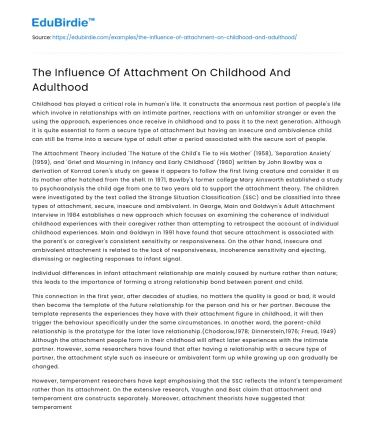Childhood has played a critical role in human's life. It constructs the enormous rest portion of people's life which involve in relationships with an intimate partner, reactions with an unfamiliar stranger or even the using the approach, experiences once receive in childhood and to pass it to the next generation. Although it is quite essential to form a secure type of attachment but having an Insecure and ambivalence child can still be frame into a secure type of adult after a period associated with the secure sort of people.
The Attachment Theory included 'The Nature of the Child's Tie to His Mother' (1958), 'Separation Anxiety' (1959), and 'Grief and Mourning in Infancy and Early Childhood' (1960) written by John Bowlby was a derivation of Konrad Loren's study on geese it appears to follow the first living creature and consider it as its mother after hatched from the shell. In 1971, Bowlby's former college Mary Ainsworth established a study to psychoanalysis the child age from one to two years old to support the attachment theory. The children were investigated by the test called the Strange Situation Classification (SSC) and be classified into three types of attachment, secure, insecure and ambivalent. In George, Main and Goldwyn's Adult Attachment Interview in 1984 establishes a new approach which focuses on examining the coherence of individual childhood experiences with their caregiver rather than attempting to retrospect the account of individual childhood experiences. Main and Goldwyn in 1991 have found that secure attachment is associated with the parent's or caregiver's consistent sensitivity or responsiveness. On the other hand, Insecure and ambivalent attachment is related to the lack of responsiveness, incoherence sensitivity and ejecting, dismissing or neglecting responses to infant signal.
Save your time!
We can take care of your essay
- Proper editing and formatting
- Free revision, title page, and bibliography
- Flexible prices and money-back guarantee
Individual differences in infant attachment relationship are mainly caused by nurture rather than nature; this leads to the importance of forming a strong relationship bond between parent and child.
This connection in the first year, after decades of studies, no matters the quality is good or bad, it would then become the template of the future relationship for the person and his or her partner. Because the template represents the experiences they have with their attachment figure in childhood, it will then trigger the behaviour specifically under the same circumstances. In another word, the parent-child relationship is the prototype for the later love relationship.(Chodorow,1978; Dinnerstein,1976; Freud, 1949) Although the attachment people form in their childhood will affect later experiences with the intimate partner. However, some researchers have found that after having a relationship with a secure type of partner, the attachment style such as insecure or ambivalent form up while growing up can gradually be changed.
However, temperament researchers have kept emphasising that the SSC reflects the infant's temperament rather than its attachment. On the extensive research, Vaughn and Bost claim that attachment and temperament are constructs separately. Moreover, attachment theorists have suggested that temperament has no direct impact on the quality of attachment since such a difficult temperament can be accommodated by sensitive caregivers, who can still develop a secure attachment bond. However, on the other hand, temperament researchers have kept reiterating that the interactions between the child and parent in the Strange Situation reveal the infant's temperament rather than the quality of the relationship. Mangelsdorf and Frosch have suggested that the results of infant temperament on attachment may be indirect and modified by other maternal and social variables.
The development of molecular genetic studies has changed the perspective of research toward specific genes, finding some genetical evidence in twins. The strategy of it is whether the relationship between parent and child are prescripted before the child had been born. The research done by Finkel and Matheny in Louisville Twin Study (LTS) found out some environmental factors, but the genetic effect on secure vs insecure attachment was not significant.
The childhood attachment the infant forms with their primary caregiver will subsequently affect the relationship with their partner. Because in the end, people seek the closeness with each other and that recall the reaction they once have with their parent. There are three basic kinds of attachment people can have with other adults. Firstly is secure attachment which consists of about 60 per cent of people. Secondly, anxious attachment, it might appear that people with this kind of attachment could be coercive, demanding and neglecting the need of their partner. Thirdly people with avoidant attachment are more likely to reject intimate contact or be close to others. However, the study shows that people who are an avoidant type of attachment other teams up with people who are an anxious attachment.
Although infants might have differences on their temperament, genes or have raised by various kind of parenting style; the only thing that surely matters is the quality of the closeness child feel which is how a parent responds to the child's signal. The attachment theory helps people to understand more with themselves in order to properly interact with people who are a different kind of attachment. Almost no person is purely anxious, or avoidance people were just a bit like that some of the time.






 Stuck on your essay?
Stuck on your essay?

